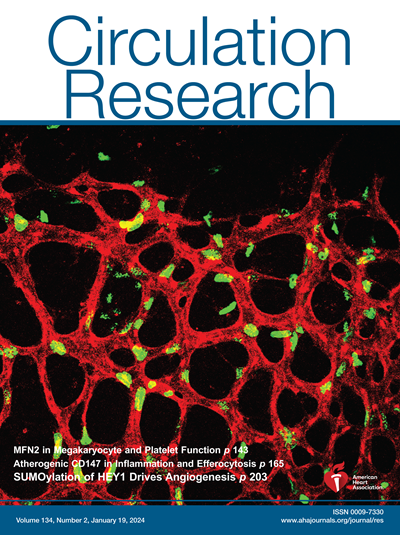C-反应蛋白的剪切感应:将主动脉瓣狭窄与炎症联系起来
IF 16.5
1区 医学
Q1 CARDIAC & CARDIOVASCULAR SYSTEMS
引用次数: 0
摘要
背景CRP(C 反应蛋白)是一种典型的急性期反应物。当五聚体异构体(pCRP [五聚体 CRP])解离成单体亚基(mCRP [单体 CRP])时,它具有促血栓形成和促炎症的活性。在主动脉瓣狭窄(AS)中观察到的病理生理剪切率会影响蛋白质的构象和功能,正如在 vWF(von Willebrand 因子)中观察到的那样。为了确定病理剪切率对人类 CRP 功能的影响,我们将 pCRP 置于病理生理相关剪切率下,并使用生物物理和生物化学方法进行分析。为了研究剪切力对体内 CRP 构象的影响,我们使用了小鼠动脉狭窄模型。在经导管主动脉瓣植入术前后测量了重度强直性脊柱炎患者体内 mCRP 和 pCRP 的水平,并在因重度强直性脊柱炎而接受主动脉瓣置换手术的患者切除的瓣膜上调查了 CRP 的存在。然后使用强直性脊柱炎的微流控模型重现强直性脊柱炎患者的剪切率,并研究 pCRP 的剪切依赖性解离及其炎症功能。结果在高剪切率下,pCRP 解离成促炎单体(mCRP)并聚集成大颗粒。我们的体外研究结果在小鼠颈动脉狭窄模型中得到了进一步证实,在该模型中,服用人pCRP会导致mCRP在狭窄后沉积。接受经导管主动脉瓣植入术的患者在经导管主动脉瓣植入术前与经导管主动脉瓣植入术后相比,与循环微囊结合的mCRP明显更高。在强直性脊柱炎的微流体模型中,pCRP发生解离,并通过ICAM-1和P-选择素表达的增加诱导内皮细胞活化。这种将 pCRP 分解为 mCRP 的新型机械传感机制很可能也与其他涉及剪切率增加的病症有关,如动脉粥样硬化和损伤的动脉。本文章由计算机程序翻译,如有差异,请以英文原文为准。
Shear-Sensing by C-Reactive Protein: Linking Aortic Stenosis and Inflammation.
BACKGROUND
CRP (C-reactive protein) is a prototypical acute phase reactant. Upon dissociation of the pentameric isoform (pCRP [pentameric CRP]) into its monomeric subunits (mCRP [monomeric CRP]), it exhibits prothrombotic and proinflammatory activity. Pathophysiological shear rates as observed in aortic valve stenosis (AS) can influence protein conformation and function as observed with vWF (von Willebrand factor). Given the proinflammatory function of dissociated CRP and the important role of inflammation in the pathogenesis of AS, we investigated whether shear stress can modify CRP conformation and induce inflammatory effects relevant to AS.
METHODS
To determine the effects of pathological shear rates on the function of human CRP, pCRP was subjected to pathophysiologically relevant shear rates and analyzed using biophysical and biochemical methods. To investigate the effect of shear on CRP conformation in vivo, we used a mouse model of arterial stenosis. Levels of mCRP and pCRP were measured in patients with severe AS pre- and post-transcatheter aortic valve implantation, and the presence of CRP was investigated on excised valves from patients undergoing aortic valve replacement surgery for severe AS. Microfluidic models of AS were then used to recapitulate the shear rates of patients with AS and to investigate this shear-dependent dissociation of pCRP and its inflammatory function.
RESULTS
Exposed to high shear rates, pCRP dissociates into its proinflammatory monomers (mCRP) and aggregates into large particles. Our in vitro findings were further confirmed in a mouse carotid artery stenosis model, where the administration of human pCRP led to the deposition of mCRP poststenosis. Patients undergoing transcatheter aortic valve implantation demonstrated significantly higher mCRP bound to circulating microvesicles pre-transcatheter aortic valve implantation compared with post-transcatheter aortic valve implantation. Excised human stenotic aortic valves display mCRP deposition. pCRP dissociated in a microfluidic model of AS and induces endothelial cell activation as measured by increased ICAM-1 and P-selectin expression. mCRP also induces platelet activation and TGF-β (transforming growth factor beta) expression on platelets.
CONCLUSIONS
We identify a novel mechanism of shear-induced pCRP dissociation, which results in the activation of cells central to the development of AS. This novel mechanosensing mechanism of pCRP dissociation to mCRP is likely also relevant to other pathologies involving increased shear rates, such as in atherosclerotic and injured arteries.
求助全文
通过发布文献求助,成功后即可免费获取论文全文。
去求助
来源期刊

Circulation research
医学-外周血管病
CiteScore
29.60
自引率
2.00%
发文量
535
审稿时长
3-6 weeks
期刊介绍:
Circulation Research is a peer-reviewed journal that serves as a forum for the highest quality research in basic cardiovascular biology. The journal publishes studies that utilize state-of-the-art approaches to investigate mechanisms of human disease, as well as translational and clinical research that provide fundamental insights into the basis of disease and the mechanism of therapies.
Circulation Research has a broad audience that includes clinical and academic cardiologists, basic cardiovascular scientists, physiologists, cellular and molecular biologists, and cardiovascular pharmacologists. The journal aims to advance the understanding of cardiovascular biology and disease by disseminating cutting-edge research to these diverse communities.
In terms of indexing, Circulation Research is included in several prominent scientific databases, including BIOSIS, CAB Abstracts, Chemical Abstracts, Current Contents, EMBASE, and MEDLINE. This ensures that the journal's articles are easily discoverable and accessible to researchers in the field.
Overall, Circulation Research is a reputable publication that attracts high-quality research and provides a platform for the dissemination of important findings in basic cardiovascular biology and its translational and clinical applications.
 求助内容:
求助内容: 应助结果提醒方式:
应助结果提醒方式:


